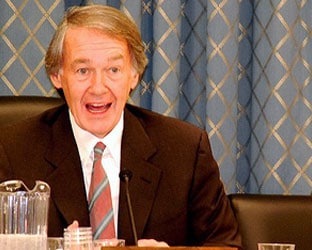An influential Member of Congress has asked no less than 20 car manufacturers to ensure that access to kHz-band radio broadcasts remains omnipresent across all of their vehicles — including electric vehicles.
But, does Ed Markey have enough influence to get the car and truck makers to say yes, given the growing removal of AM radio from EVs due to interference — caused by the cars and not by the signals themselves?
Markey (D-Mass.), a member of the Senate Commerce, Science, and Transportation Committee, on Thursday sent letters to the car manufacturers pleading for the retention of AM radio accessiblity.
In his letter, Markey explained that consumers still value AM radio. In the state he represents, there’s no bigger example of this than iHeartMedia-owned News/Talk WBZ-AM 1030, long a key voice across Boston and much of New England. Unlike other spoken word AMs, it does not have an FM translator covering the city. Even if it did, listeners from across the region likely wouldn’t be able to tune in to the micro-MHz signal.
Markey stressed that “free broadcast radio” is “a critical, reliable channel for local, state, and federal government officials – including the President of the United States, governors, mayors, and emergency management and public safety officers – to communicate with the public.”
Perhaps the biggest takeaway from Markey’s letter was a request to automakers to adopt technological solutions to address any electromagnetic interference that EVs cause with AM radio signals.
That’s the No. 1 reason why AM radio is largely problematic in EVs, leading brands such as Tesla and, more recently, BMW, to remove AM accessibility from their EVs.
Automotive technology expert Jim Motovalli recently discussed AM radio’s future in automobiles in an interview airing on WPKN-FM in Bridgeport, Conn., excerpts of which were shared in a recent InFOCUS Podcast, presented by dot.FM.
Markey wrote, “Despite innovations such as the smartphone and social media, AM/FM broadcast radio remains the most dependable, cost-free, and accessible communication mechanism for public officials to communicate with the public during times of emergency. As a result, any phase-out of broadcast AM radio could pose a significant communication problem during emergencies. Although the auto industry’s investments in electric vehicles are critical to addressing the climate crisis and reducing greenhouse gas emissions, automakers need not sacrifice the benefits of radio in the process.”
The letters were sent to car manufacturers BMW, Ford General Motors, Honda Motor, Hyundai, Jaguar Land Rover, Kia, Lucid, Mazda, Mercedes-Benz, Mitsubishi, Nissan, Polestar, Rivian, Stellantis, Subaru, Tesla, Toyota, Volkswagen Group, and Volvo.
And, Markey has asked for written responses to a series of questions, with responses due by December 22:
- Has your company decided to discontinue access to free AM and/or FM broadcast radio in any of its vehicles?
- If so, please provide the make, model, and manufacturing year of each vehicle that no longer will have AM and/or FM radio and explain why your company decided to omit AM and/or FM radio from those vehicles.
- If not, please explain the type of technology, if any, that addresses electromagnetic interference with AM radio signals from EVs.
- Does your company have any plans to omit AM and/or FM broadcast radio from future vehicle models? If so, please explain why your company is planning to remove AM and/or FM broadcast radio from them.
- Does your company include free, digital broadcast radio in its vehicles? If so, please provide the make, model, and manufacturing year of each vehicle equipped with digital broadcast radio.





